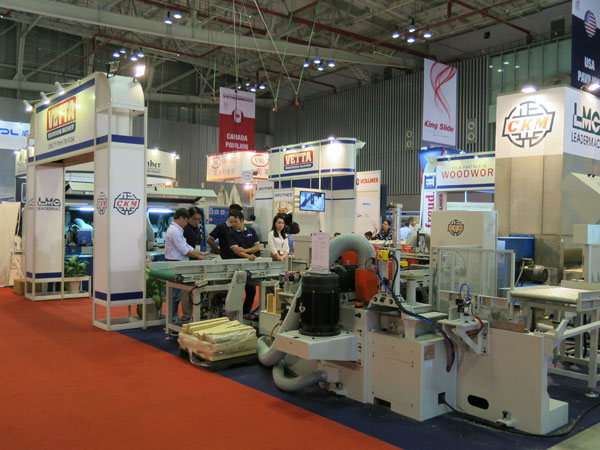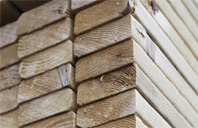Market Outlook 2016
At the dawn of a new year, Michael Buckley, World Hardwoods, shared his insight on how the global market will evolve in 2016.
Today’s world is troubled—by terrorism, by political change, by currency and interest instability, by collapsing oil prices, by lack of confidence in future demand growth and by major environmental issues that affect all countries. That makes 2016 a difficult year to predict.

As at every New Year, most individuals are full of optimism, so let us start by laying to rest the macro issues that affect us today. The world will hopefully address, confront and possibly reduce the threat of terrorism; and Trump or no Trump, there will be new leadership in the US by year end.
Currencies have always affected business so nothing new there; and interest rates will remain low. The oil price crisis also presents opportunities of lowering costs. That leaves investor and consumer confidence as one major issue affecting demand for the products we all need for living. Finally, nobody now doubts the need of humanity to address pollution of the environment, especially in Asia, and to confront the predicted climate change by reducing carbon impact.
Specifically in Asia are the big questions about China. Will its industrial and consumer growth continue to slow, even though the late 2015 level is way above that of other industrialised countries? Will China further reduce its need for commodities that have helped to prop up regional economies as far as Indonesia and Australia? And what will China do with its currency and huge exchange reserves? These are the real unknowns which make predicting 2016 so difficult.
One certainty is that China will continue to need forest raw material in the short, medium and long term, so trade opportunities remain strong. Looking further forward beyond 2016 there are the potential effects of the Trans Pacific Partnership (TPP), if ratified and especially if eventually China and South Korea join in.
Prospect Of Timber Sector
So what might be the significant trends that will emerge in the wood harvesting and processing sectors for the coming year? Increased use of plantation wood at the lower end of the market is likely, especially in Malaysia, Indonesia, Australia/New Zealand and even Japan. China is also planting heavily and, as with other densely populated countries like India, is restricting the harvesting of its natural forests.
So the next question is whether the global community, the ENGOs, governments and civil society will finally get on top of illegal logging that not only destroys forest’s futures but inhibits investment and disrupts fair trade.
One thinks of Russian material arriving in China, as demonstrated by the case of Lumber Liquidators under Lacey, and the constant stream of material from Indochina into Vietnam. No legislation in USA, EU or Australia has deterred that trade. A more positive trend has been the long established achievement of Malaysia, and the progress of Indonesia to stamp out illegal logging, which is expected to continue.
The plans of organisations with which we work as consultants are quite clear—to continue the path in Asian markets in 2016 that has produced results in the past and has a way to go yet. Specifically the American hardwood industry has invested so much time and energy in levelling the playing field so that now with American Hardwood Environmental Profiles (AHEPs) it is able to provide users in Asia with science-based data that shows environmental impact, shipment by shipment for any given hardwood species. And that is important when one hears of a US$20 million programme by the so-called ‘green’ concrete industry to attack timber as a construction material.
In any case the attraction of high quality – high value imported hardwoods are self-evident, given the insufficiency of locally grown material for furniture, flooring and joinery. The Programme for the Endorsement of Forest Certification (PEFC) has made rapid progress in Asia in support of national schemes, some of which are well advanced, and it will continue to do so.
Promising Construction Material
It is a fact however that the forest products industry falls behind other man-made or fossil-fuel materials in terms of technology upgrade, product innovation and market expansion. One exception to this is the development of engineered wood products such as glulam and now cross-laminated timber (CLT) that is changing the minds of architects and engineers.
There are of course pros and cons. The benefit of CAD produced CLT components for fast erection and lighter buildings requiring less piling, is perhaps one threat seen by the concrete industry! But the current trend to high rise timber buildings is a trend that will surely continue.
The bottleneck however has two major elements. First is the ‘chicken and egg’ syndrome of no local plant until the market develops which cannot happen without local CLT production; and the other problem is transport. CLT Components do not easily fit into trucks or containers. So far only softwood has been used on a commercial scale for CLT, but American Tulipwood has been successfully trialled and may lead the way to other hardwoods for this new, exciting, forest product.
Asian Landscape
As always in any year, the main driver for wood industries is construction activity and confidence in real estate property. The US market is on the up, if we are to believe the Federal Reserve Bank, but the reverse may be true in much of Europe—unless they start building homes for refugees, as increasing population drives construction and furnishings.
Construction in Asia remains speculative against the background of a long-term perceived shortage of housing, as standards of living grow for the masses especially in China. Despite the improvement in demand in some markets, which caused American hardwood prices to rise, for example, volatility in prices influenced by China has been, and remains another destabilising issue for wood producers.
However the ongoing challenge to the wood industry still comes from substitutes, which we continue to see at Interzum in Guangzhou with plastic laminates and foils, looking increasingly realistically like wood. At Domotex in Shanghai the non-wood flooring sector grows bigger every year, in a show now almost exclusively focused on the Chinese domestic market, rather than exports.
And bamboo, with all its false environmental claims, is presenting another challenge to solid and engineered wood flooring. Used in the round, bamboo is green enough, but when processed flat for flooring using high energy, chemicals and adhesives, bamboo falls way behind wood in environmental impact.
So where does all this lead for a reasonable prediction? The most optimistic factor now is the growing realisation by architects, designers, engineers and even developers, that wood is good. It really is and they know it! That does not mean that consumers still feel tree-felling may be wrong, so the industry has much left to do in order to improve its public image.
Come in forest certification, as one method of restoring consumer confidence. There is now a strong trend in Asia for national forest certification schemes being set up for endorsement by PEFC. These include Vietnam, Thailand, Indonesia, China and Japan, with others considering—all following in the steps of Malaysia.
On the processing sector one can take snippets of evidence to predict trends, of which the IFMAC machinery show in Indonesia was an example in 2015. Some of the world’s big woodworking machinery manufacturers invested heavily in exhibiting, which gave thought to the idea that they have increasing confidence in wood processing prospects in Southeast Asia. Finally, on a day to day basis, most wood processors and wood product manufacturers in Asia will be watching interest and currency exchange rates very closely in 2016.(fdmasia)





 沪公网安备31010402003309号
沪公网安备31010402003309号



